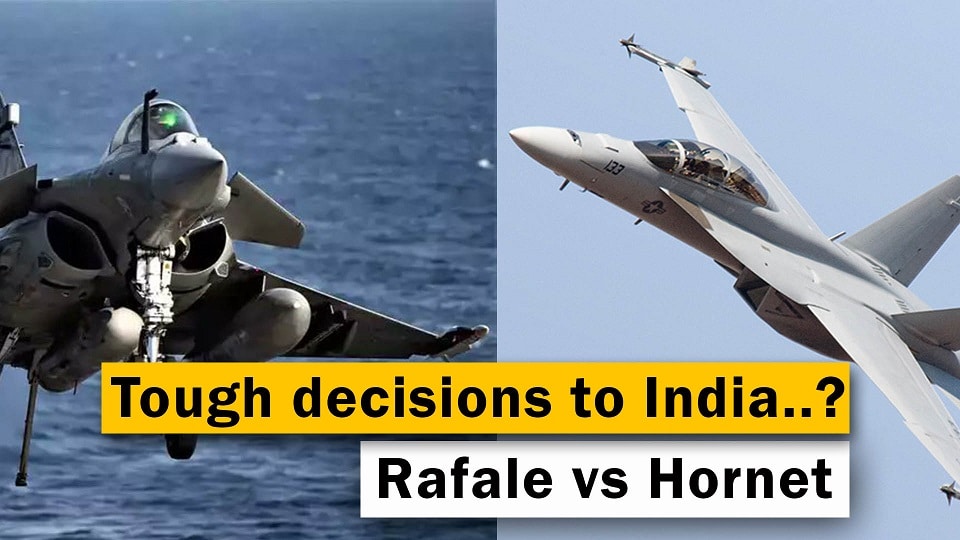Aviation
Why choosing between the Rafale and Hornet F/A 18 aircraft is difficult. Is India still awaiting offers?

The search for suitable aircraft to be deployed on INS Vikrant, India’s indigenous aircraft carrier, began in earnest last year. The naval variant of the French company Dassault’s Rafale fighter jet (the Rafale Marine), as well as Boeing’s F/A-18 Super Hornet, have emerged as the top two contenders over the previous few years. India looked at both in depth.
The main issue is determining the criteria for equipping the Indian defense squad with the appropriate fighter jet. As the F18 aircraft will be extended if India places a new order, or if Boeing closes the F18 production facility, it will continue to maintain the present fleet. Another Rafale 18 is on the current list, however, it is a single-seat marine fighter jet.
Rafale-M and Super Hornet both have their advantages due to similar standardization, but where can India obtain a better deal?
The Indian Navy was delighted by the Rafale-M’s flawless maneuverability. The F/A-18’s potential for Indian aircraft carriers was similarly shown by Boeing in the US in late 2020. Finally, in 2022, at the Indian Naval Station Hansa in Goa, where INS Vikrant’s flight deck was modeled, the two competing multi-role carrier-borne fighters (MRCBF) were requested for operational demonstration tests. The first to enter service was the Rafale-M in February 2022, and Super Hornet in July.
A fighter plane with a similar configuration, the Rafale Marine is designed for the navy. The aircraft is offered in single- and dual-seat configurations, has a delta wing shape, and can resist 11 g. It is 15.27 meters in length and 10.80 meters in width. The GIAT 30M/719B gun on the Rafale is installed on it and has controlled 0.5 or 1-second bursts at 2500 RPM. It has a main missile that can be fired in multi-target fire and forget mode. In addition to the Meteor for battle beyond visual range, the aircraft is also capable of carrying air-to-air MBDA MICA missiles.
In comparison to the Rafale, the F/A-18 has a 20% larger airframe, 41% longer range, and better General Electric F414 engines that produce 35% more thrust. It was created by American aerospace and defense company Boeing. Similar to the Rafale, it travels at a speed of 1.8 Mach. The M61A1 Vulcan revolving canon of the F/A-18 had a maximum rate of fire of 6,000 rounds per minute. It has an AIM-7 Sparrow homing air intercept missile with a semi-active radar. The Super Hornet is equipped with AIM-120 AMRAAM beyond visual range air-to-air missiles.
The government will make the decision in this case. We have accepted both. The Ministry of Defence (MoD) will now make the decision. Both aircraft are in good shape. They have established their worth. However, there will now be additional problems. For instance, the Air Force already has Rafales. The Navy Chief said, “Now there will be a commonality for spare parts and support etc.
The Navy currently operates a Russian MiG 29K for INS Vikrant. But it wants to go for a completely indigenous fighter jet in the future and imported Rafale M or Super Hornet.
The ‘economy’ of the transaction would also be important given that India paid INR 59,000 crores (more than US$8 billion) for 36 Rafale aircraft for the IAF.Even though it would be the maritime version of the Rafale, it is thought that France may offer a better deal on “add-on” aircraft.

Aviation
Boeing, Antonov to Collaborate on Defense Projects

– MOU represents Boeing’s commitment to work with Ukrainian industry
– Includes exploring opportunities for collaborating on in-country support of Unmanned Aerial Systems
A Memorandum of Understanding was signed today by Boeing and Antonov Company to investigate potential collaboration on defense-related projects.
“We’re happy to keep collaborating with the Antonov Company to help Ukraine’s economic development and expansion,” stated Ted Colbert, CEO and president of Boeing Defence, Space, & Security.
Airbus and the Antonov An-225: The Best Partnership:Click here
“This agreement demonstrates our ongoing efforts to find more opportunities to work with Ukrainian industry, which was underscored by our signing of the Ukrainian Defence Industry Compact earlier this year.”
The areas of potential collaboration identified in the agreement consist of training, logistical support and overhaul services for tactical Unmanned Aerial Systems utilized by the Ukrainian Armed Forces, which includes the ScanEagle. In addition, the companies will also explore opportunities for Antonov to provide engineering support to Boeing.
The six largest cargo aircraft ever built in the aviation industry:Click here
“A strong, innovative, and efficient defense industry is key to sustainable economic development and national security, and we are extremely excited to collaborate with Boeing,” said Ievhen Gavrylov, CEO of Antonov Company.
This agreement brings a whole new level of opportunity to implement the latest and most effective solutions – in addition to the possibility of future projects with Boeing in the aerospace and defense industry.”
-

 Travel1 week ago
Travel1 week agoAir India to Expand US Operations with Three New Routes After a Decade
-

 Travel2 weeks ago
Travel2 weeks agoWhy We Should Avoid These Stamps in a Passport
-

 Airlines1 month ago
Airlines1 month agoInvestigations Reveal Fake Chinese Titanium in Boeing and Airbus Jets
-

 Tech4 weeks ago
Tech4 weeks agoChina’s CATL Plans 1,800-Mile Electric Plane Launch by 2027
-

 Airport3 days ago
Airport3 days agoTop 10 Largest Airports in the World by Size
-

 Aerospace4 weeks ago
Aerospace4 weeks agoChina’s Fighter Jets Turn Wings into Autonomous Drones
-

 Airlines4 days ago
Airlines4 days agoAir India Rolls Out A350s for Delhi-New York JFK and Newark Routes
-

 Defence3 weeks ago
Defence3 weeks agoBoeing Enhances Chinook with New Engines and Block II Upgrades at $96 Million







